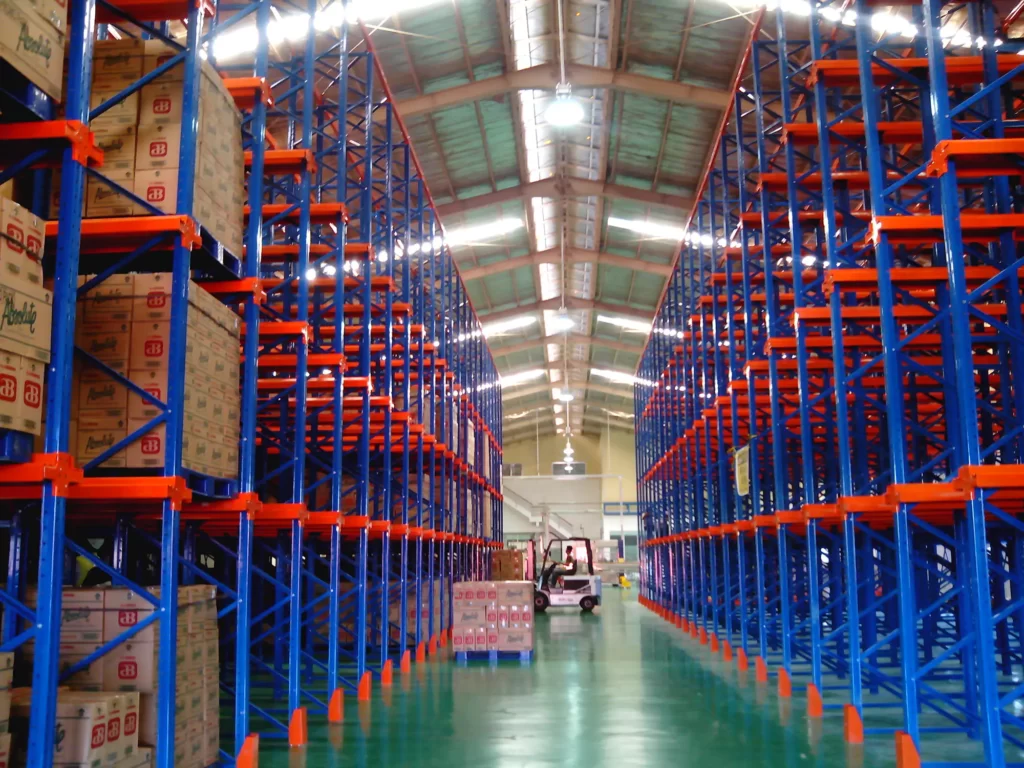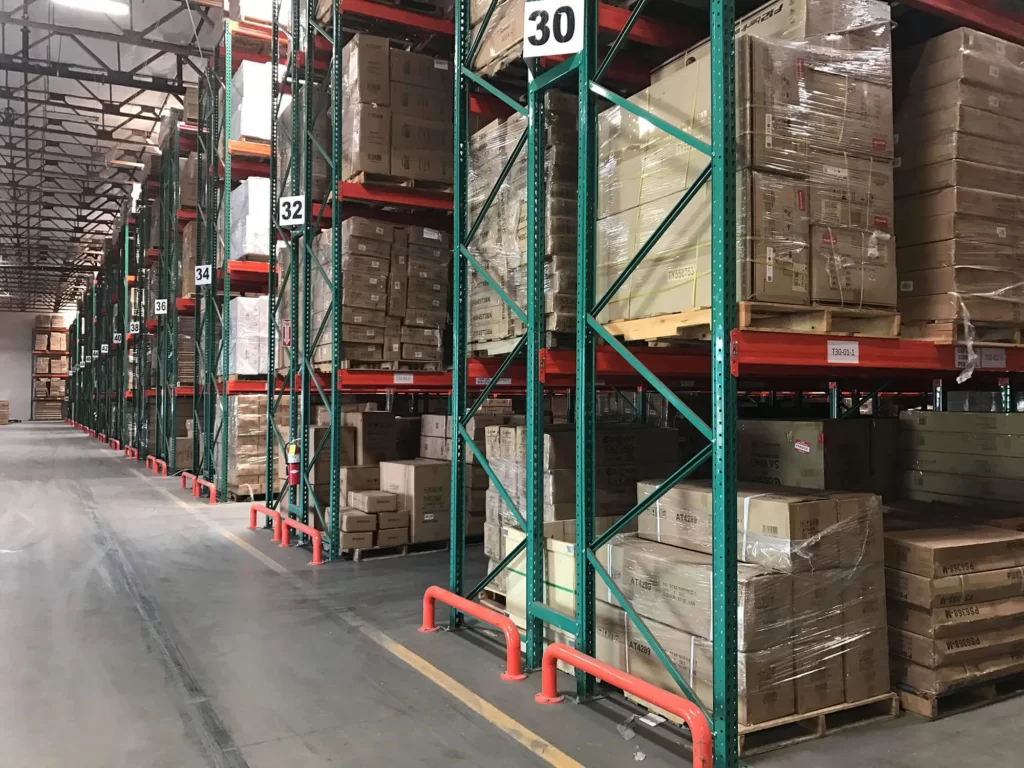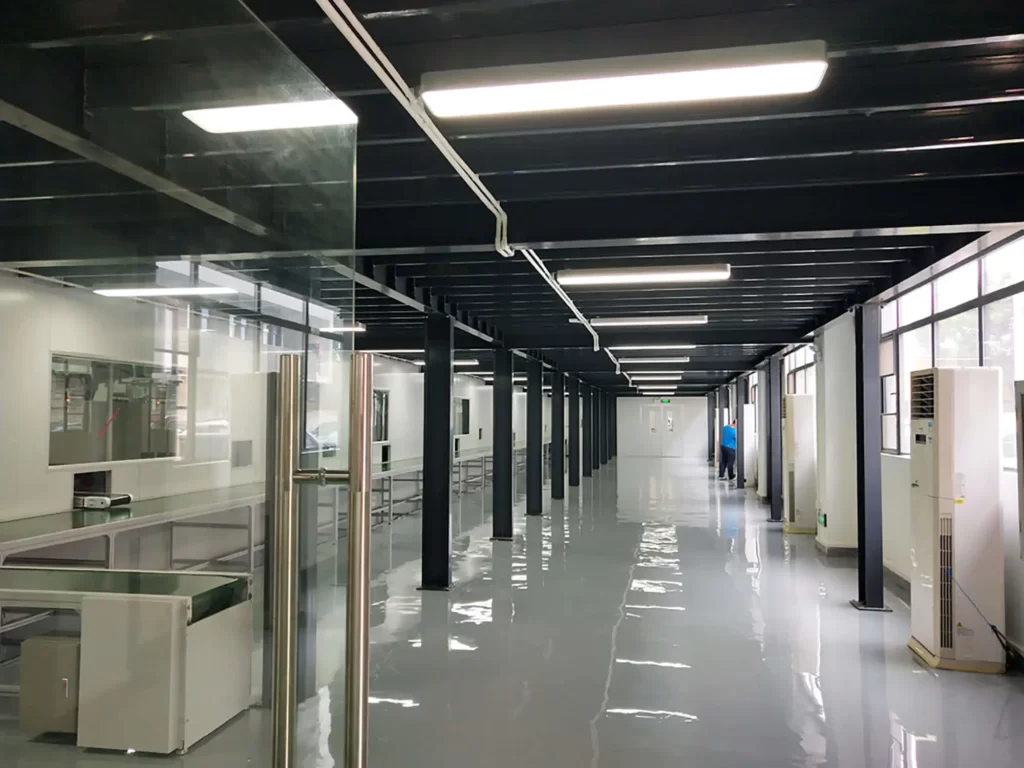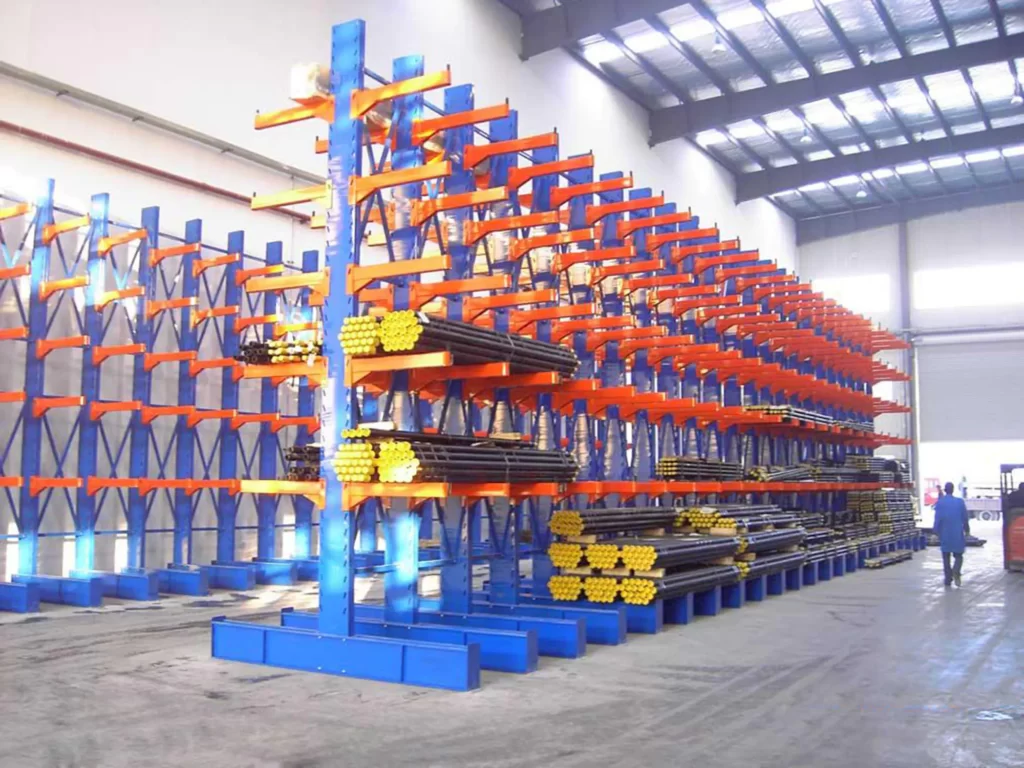Automated cold storage, is mainly a fully automated storage controlled by computer, while the use of prefabricated assembly type heat insulation maintenance structure of the single-story cold storage, with a multi-layer high rack made of light steel for the storage of pallets of goods, and then the goods carried on the pallets rely on the stacker crane, and then according to the instructions of the electronic computer free and orderly shuttle in the automated cold warehouse, and then from the specified compartment to remove or Put the goods into the pallet, and use the plane conveyor belt for the automatic operation of goods in and out of the warehouse. The dense intelligent cold chain storage is also equipped with an air cooler, a device that forms a low-temperature air layer in the upper space of the storage room, which is cooled by convection to maintain the set temperature inside the storage. There is no need for any human involvement.
Automated cold storage system structure
The whole automated cold warehouse system can be divided into receiving area, a low-temperature storage area, a shipping area, two buffer areas, a loading area and a monitoring area.
1 Receiving area
Responsible for the classification and sorting of incoming goods. Its process flow is as follows: palletizing – strapping – information input – pallet deposit – transport trolley into the buffer zone.
(1) Palletizing: Put the goods into the pallet, input the goods information into the system through the RF handheld terminal and bind it to the pallet.
(2) Put the stacked materials into the warehouse conveyor of the automated warehouse by forklift, press the confirmation button, and fix the barcode reader to read the pallet information.
(3) The LED electronic display below the entrance of the warehouse shows the name, specification, quantity and batch number of the material.
(4) The system automatically detects the shape and weight of the pallet goods in the warehouse and the qualified goods pass and the unqualified goods exit from the reorganization.
(5) After the shape check is passed, the goods are put into the designated position of the automated warehouse through the chain conveyor, RGV trolley and stacker crane.
(6) Computer carries out processing afterward.
(7) The warehousing operation is completed.
2 Buffer zone
Responsible for the connection between the incoming and outgoing line area and the low-temperature storage area. It is an isolation area under a low temperature without manual operation. Both ends of the buffer zone are automatic sliding cold storage doors. When goods enter and exit the storage area, one of the two doors is always closed, effectively preventing the invasion of internal heat sources to the automated cold chain storage, reducing the heat load and temperature fluctuations during the movement of the cold storage.
3 Low-temperature storage area
It is responsible for the low-temperature storage of quick-frozen products, and the storage and access operations are controlled by a computer. It is a non-personnel operation area. After the goods enter the storage area, according to the computer setting, the conveyors transport the goods to the lane stacker of the designated racks, and then the stacker is placed in the designated storage position. As shown in the figure, there are 7 lanes with a height of 20 meters, and each lane within the area is equipped with a stacker crane for the inbound and outbound operation of the goods on top of the racks. The racks are double-positioned beam combination racks with 14 rows, 28 columns and 9 levels, with a total of 7056 pieces. It is mainly used for the storage of frozen products, west storage and east out, to improve the operation efficiency and reduce the operation cost. The working temperature of the storage area is -20℃. To meet the requirements of low temperature, a cooling fan is installed at one end of the reservoir.
4 Delivery area
Responsible for the delivery and loading of products.
(1) The warehouse management system receives delivery orders from the ERP system, or the operator enters the delivery order directly on top of the warehouse computer.
(2) The computer automatically generates delivery tasks and queues them for work according to certain priority principles.
(3) The computer sends the order to each corresponding area and equipment.
(4) According to the computer specified discharge position (automatic discharge operation according to WMS command), the ingredients of the specified storage place are sent to the conveyor above the bin end of the automated warehouse, and then the goods are delivered to the corresponding picking port or the whole pallet of the warehouse by RGV trolley.
(5) Below the exit, the corresponding LED electronic display shows the name, specification, quantity and order number of the warehouse material.
(6) Operators send the goods to the staging area according to the order
(7) According to the exit order, the operator can operate manually or with a forklift and send the goods to the temporary storage area.
(8) computer for over-account processing
5 Loading area
The area near the loading isolation door. This area is mainly used for the storage, sorting and distribution of goods during the outbound operation (with trucks).
6 Automated warehouse monitoring area
Machine room. The computer terminal of the monitoring room is set adjacent to the exit and is used for computer operation and equipment monitoring. Mainly used for monitoring and management of the entire warehouse area.
Dense intelligent automated cold storage advantages
1. The loading and unloading of goods in cold storage and stacking are all fully automatic and intelligent, without any personnel operation, which can save human resources.
2. With the use of an automated cold warehouse, the goods loading and unloading and stacking more quickly, and throughput is larger.
3. Cold storage is managed by a computer, and it can provide the name, quantity, location and temperature history of goods in stock at any time, and automatically settle the storage cost, which can improve management efficiency and greatly reduce staff labor.
4. The use of the automated cold warehouse, but also to ensure that the goods are in accordance with the “first in first out” principle to manage, greatly improving the quality of storage of goods.
6. In and out of the automated cold warehouse belongs to the unmanned access, and the opening and closing doors are set for two doors, the size of the door is much smaller than the traditional automated cold chain storage so that the opening and closing door action time is reduced to about 30%, which guarantees the stability of the cold storage temperature, but also to protect the quality of goods.
7. Automated frozen warehouse in the automated warehouse will generally have more than one temperature zone, the temperature of the cargo area is generally controlled at 0 ~ +7 ℃, in addition, will also involve the buffer room, which may also involve the division of the temperature zone such as independent de-temperature room, and the temperature of the storage area will generally be between 0 ~ -40 ℃.
Mracking automated cold storage is better than other manufacturers’ cold storage, mainly in the following aspects
01. Stronger safety
Mracking cold storage refrigeration system is designed according to international standards of refrigeration technology, the safe operation of its refrigeration system set up a full range of computer monitoring operations, and you can monitor the key parameters of the system operation, such as the operating status of the operating equipment, the liquid level position of the stationary container, the temperature of the automated frozen warehouse, etc., when the system is abnormal, the system can be automatically processed, and instantly issuing an alarm.
02. Set leak monitoring
This system device is installed with a large number of ammonia leakage electronic alarm meters, which is linked with the automatic control valve of the refrigeration system, when the alarm meter detects ammonia leakage, the corresponding electric control valve will be processed immediately, thus eliminating the occurrence of a large area of leakage, but also immediately issued an alarm to notify the equipment management personnel to deal with.
03. Ammonia filling quantity is small
This system device is mainly used for energy-saving secondary throttling, gravity supply system, and regarding the experience of the design of refrigeration systems for the precise optimization of calculations, the amount of ammonia charging in the system is only 4.6 tons, it is much lower than the number of dangerous chemicals and other major sources of danger boundary 10 tons.
04. advanced melting process
The melting time of most domestic hot ammonia melting systems is more than 50 minutes, and it may take more than one hour to melt clean. The system set up by Mracking adopts the fully automatic hot ammonia melting process, the chiller melting time is only 18 minutes, and the melting is very clean.
05. Higher degree of automation
Mracking cold storage system is fully automatic operation, the degree of automation is relatively high, when the normal work is not required to be manually operated; when there is a manual operation need, only need to issue instructions to the system operation, the system will automatically implement the contents of the instructions, thus eliminating the safety risks caused by manual operation errors. At the same time, this system also adopts four units of parallel screw refrigeration units, which can automatically adjust the cooling capacity according to the cooling demand.
The smooth operation process of Mracking Dense intelligent automated cold storage is as follows.
1 Inbound
According to different customers to establish customer and cargo information, each customer in the WMS system has a piece of independent file information. The system management staff will set up the goods entry sheet in the WMS system according to the goods name, batch number, quantity, specification and other information according to the customer’s delivery order, at this time, the relevant information of this sheet will be automatically entered into the computer, and the stocker will check the information of the new sheet in the computer according to the customer’s delivery order, and scan the pallet number according to the actual goods, and the forklift will put the scanned pallet on the conveyor to carry out the storage operation automatically, and the storage will be After that, the stacker crane will send the pallet into the storage space according to its system instruction. When the storage is completed, the cargo location information, pallet number information and cargo information will be bound as inventory information and the system will issue the operation document.
2 Storage
According to the characteristics of goods selected for storage, different goods are stored according to the partition. The incoming goods can be stored in isolation, and according to the characteristics of different goods and customer needs, the WMS system will classify the storage status of goods into qualified, pending inspection, unqualified, etc. The goods in the inventory can also be queried online through the information related to product specifications, batches, suppliers, etc. so that the whole process of monitoring the stored goods can be achieved.
3 Picking
The system management staff will establish the goods release order according to the customer’s order, and set it in the system according to the customer’s individual requirements, while the system will make first-in-first-out or selective release for the batch of goods.
4 Outbound storage
When the document picking is completed, the system management staff will click out of the warehouse, and at this time the stacker will automatically look for the warehouse position of the goods and out of the warehouse according to the document information, and the stocker will arrange the shipping operation according to the shipping port display, and when the operation is completed, the system will issue the operation document.








